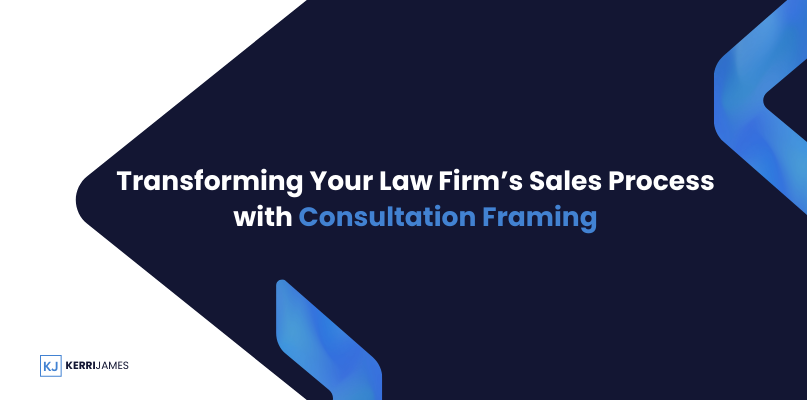Let’s face it, the word “intake” doesn’t exactly spark joy. It evokes images of paperwork, processes, and a certain coldness – not the ideal feeling you want potential clients to have when reaching out to your firm for help. What if there was a better way, a more human-centered approach that positions your firm as a trusted advisor from the very first interaction? There is, and it’s called consultation framing.
This shift from the traditional intake process to a consultation-based approach can be a game-changer for your law firm. Instead of viewing that crucial first call as a data-gathering exercise, consultation framing encourages your team to see it as an opportunity to build rapport, understand the client’s unique needs, and ultimately, provide a solution that resonates with them on an emotional level.
What is Consultation Framing?
Consultation framing is all about shifting your perspective on the intake process. It’s about moving away from a transactional model focused solely on collecting information and securing a signature, towards a more collaborative and empathetic approach that prioritizes building trust and understanding.
Think of it this way: You wouldn’t walk into a doctor’s office expecting to fill out a mountain of paperwork before even speaking to a nurse, right? You’d want someone to hear your concerns, understand your symptoms, and provide reassurance that you’re in the right place. That’s exactly the experience you want to create for potential clients during your initial consultation.
Here’s a breakdown of the key differences between a sales-focused consultation and a traditional information-gathering intake:
Traditional Intake:
- Focus: Gathering information, often through lengthy forms or questionnaires.
- Communication Style: Formal, procedural, and often impersonal.
- Goal: Securing a signature on a retainer agreement as quickly as possible.
- Client Experience: Can feel overwhelming, impersonal, and transactional.
Consultation Framing:
- Focus: Building rapport, understanding the client’s needs and concerns, and positioning your firm as a trusted advisor.
- Communication Style: Empathetic, conversational, and personalized to the client’s situation.
- Goal: Establishing a connection, building trust, and demonstrating value to the client.
- Client Experience: Empowering, supportive, and focused on building a relationship.
By embracing consultation framing, you’re not just collecting data points; you’re building a foundation of trust and understanding that can transform a hesitant lead into a loyal client.
The Psychology of Client Conversations
Now, let’s delve a little deeper into the psychology behind effective client conversations. Remember, people make decisions based on emotions as much as logic, especially when facing stressful situations like legal issues. Consultation framing allows you to tap into those emotional motivators and guide them towards a positive outcome.
Here are key psychological principles to leverage during your consultations:
- Active Listening and Empathy: Put yourself in your client’s shoes. They’re likely feeling stressed, vulnerable, and uncertain about the future. Active listening techniques like mirroring, labeling, and commending can help you establish a deeper connection.
- Mirroring: Subtly reflecting the client’s language, tone, and energy to create a sense of rapport. For example, if a client says, “I’m just so frustrated with how the insurance company is treating me,” you might respond with, “It sounds like you’re feeling incredibly frustrated by the way you’re being treated.” This simple act of reflecting their language back to them shows that you’re truly listening and empathetic to their situation.
- Labeling: Acknowledging and validating their emotions. For example, instead of just saying “I understand,” you might say, “That sounds incredibly frustrating. It’s completely understandable that you’d feel that way after dealing with this.” By explicitly labeling their emotions, you’re not just acknowledging their feelings, you’re validating them and demonstrating a deeper level of understanding.
- Commending: Recognizing and praising their efforts, decisions, and insights to build confidence and trust. For instance, if a client mentions that they’ve kept detailed records of their medical expenses, you might say, “That’s fantastic that you’ve been so organized. That’s going to be extremely helpful as we move forward with your case.” This positive reinforcement strengthens their trust in you and their confidence in making the right decision by hiring your firm.
- Highlighting Shared Goals: People are naturally drawn to those who share their values and aspirations. By framing your services as a partnership working towards a common goal – like securing fair compensation, protecting their rights, or achieving peace of mind – you create a powerful sense of alignment. Instead of simply listing your services, connect them back to the client’s desired outcome. For example, instead of saying, “We have extensive experience handling personal injury cases,” you might say, “Our goal is to use our expertise to fight for the maximum compensation you deserve so you can focus on your recovery.”
- Addressing Fears and Concerns Head-On: Don’t shy away from addressing the elephant in the room. Acknowledge the client’s anxieties and concerns openly and honestly. This demonstrates empathy, builds trust, and allows you to proactively address any potential objections. For example, if a client expresses concern about the legal fees, don’t brush it aside. Address it directly with empathy and provide clear explanations of your fee structure and how you work to make legal representation affordable.
- The Power of Storytelling: Stories are powerful tools for building connections and conveying complex information in a relatable way. Use anecdotes, case studies, or client testimonials to illustrate your firm’s experience, expertise, and commitment to achieving favorable outcomes. Instead of saying, “We’ve handled many cases like yours,” share a brief, anonymized story of a past client who faced a similar situation and how your firm helped them achieve a successful outcome. This makes your firm’s success more tangible and relatable.
By weaving these psychological principles into your consultations, you can transform a potentially stressful and overwhelming experience into a supportive and empowering one.
The Four S’s of Intake
Now that we’ve established the “why” behind consultation framing, let’s dive into the “how.” I advocate for a streamlined approach I call the “Four S’s of Intake”: Screen, Sell, Sign, Schedule. This framework allows you to gather essential information, build rapport, and secure a commitment efficiently and effectively, all while prioritizing the client’s experience.
- Screen: The initial screening process is crucial for ensuring you’re investing time and resources in qualified leads. While empathy and active listening remain paramount, you’ll want to quickly determine:
- Is this a case your firm handles?: Don’t waste time on inquiries outside your area of expertise. Be upfront about the types of cases you handle and have resources available to refer them to appropriate legal help if needed.
- Does the client meet your minimum criteria?: For example, if you specialize in personal injury cases, you’ll want to confirm there was an injury, it occurred within the statute of limitations, and the potential client has not already retained another attorney. These qualifying questions help you determine if you can genuinely help the client and avoid wasting their time if it’s not a good fit.
- Is there a potential conflict of interest? Maintaining ethical standards is paramount. Briefly explain the concept of conflicts of interest and ask preliminary questions to identify any potential issues early on.
By asking targeted questions early on, you can politely and professionally redirect inquiries that fall outside your firm’s scope, allowing your team to focus on those you can truly help.
- Sell: Once you’ve determined a client is a good fit, it’s time to transition into the “selling” phase. Now, before you cringe at the word “selling,” remember, it’s not about pushing a product; it’s about effectively communicating your firm’s value proposition and demonstrating how you can help solve the client’s problem.
Focus on:
- Educating the Client: Explain complex legal processes in clear, concise terms. Avoid legal jargon and focus on providing a clear understanding of their rights, options, and potential outcomes.
- Emphasizing Your Expertise: Highlight your firm’s track record, experience, and specialized knowledge. Share case results, client testimonials, or professional recognitions that demonstrate your ability to deliver successful outcomes.
- Showcasing Your Value: Clearly articulate the benefits of working with your firm, like greater peace of mind, access to resources, and potentially higher settlements. Explain how your firm goes above and beyond to advocate for your clients’ best interests.
- Positioning Yourself as the Solution: By the end of the “sell” phase, the client should clearly understand why your firm is the best choice to handle their specific legal needs. This is about building confidence in your firm’s ability to deliver results and provide the support they need during a challenging time.
- Sign: Now comes the crucial moment – securing a commitment. The key here is to strike while the iron is hot. You’ve built rapport, demonstrated your expertise, and the client is feeling positive about your firm. Don’t let that momentum fade.
- Introduce the Letter of Engagement: Keep it simple and straightforward. Focus on the essential elements like your representation agreement and fee structure. Avoid overwhelming them with legalese. Explain it in plain English, emphasizing the benefits of formalizing the relationship.
- Address any Questions or Concerns: Transparency and clear communication are essential for building trust. Be prepared to answer questions and address any hesitations the client may have. Listen actively, provide honest answers, and ensure they feel confident and comfortable moving forward.
- Make the Signing Process Seamless: Offer convenient signing options like electronic signatures or secure online portals to make it as easy as possible for the client to commit. This demonstrates your firm’s commitment to efficiency and client convenience.
- Schedule: Congratulations, you’ve secured a new client! But the work isn’t over yet. To avoid that dreaded “post-intake silence,” end the call by scheduling the next steps.
- Schedule the Onboarding Meeting: This is where you’ll dive into the nitty-gritty details of their case and gather all necessary documentation. Provide a clear timeframe for this meeting and reiterate the value they’ll gain from a more in-depth discussion.
- Set Clear Expectations: Outline what the client can expect between now and the onboarding meeting. Let them know who will be their primary point of contact, how they can reach out with questions, and what information they should start gathering.
- Provide a Timeline: Offer a realistic timeframe for next steps, like when they can expect to hear from their assigned attorney or paralegal. This manages expectations and reinforces your commitment to responsive communication.
By implementing the Four S’s, you’ll create a streamlined, client-centric intake process that maximizes conversions, reduces client anxiety, and sets the stage for a positive and productive attorney-client relationship.
Implementing Consultation Framing at Your Law Firm
Now that you understand the power of consultation framing, it’s time to put it into practice. Here’s how to make the shift at your law firm:
- Train Your Intake Team: Invest in comprehensive training for your intake team.
- Develop a Consultation Mindset: Move away from scripted responses and encourage your team to engage in genuine, empathetic conversations. Role-playing exercises can be invaluable for practicing these skills and building confidence.
- Master Active Listening Skills: Equip your team with the skills to effectively mirror, label, and commend to build rapport and trust. Provide specific examples and encourage them to adapt their communication style to each client’s unique personality and emotional state.
- Understand Your Ideal Client: Ensure your intake team has a clear understanding of your firm’s ideal client profile and can effectively screen for qualified leads. This will help them focus their energy on those most likely to convert and benefit from your firm’s services.
- Product Knowledge is Key: Make sure your intake team is well-versed in your firm’s practice areas, services, and unique value proposition. They should be able to confidently articulate your firm’s strengths and tailor their communication to highlight the most relevant aspects for each potential client.
- Reimagine Your Intake Materials: Ditch the lengthy intake forms and opt for a more user-friendly approach.
- Simplify Your Letter of Engagement: Make it concise, easy to understand, and focused on the essential elements. Consider providing a separate document with FAQs about your firm’s fees, services, and client expectations.
- Create Engaging Welcome Materials: Develop visually appealing and informative brochures, website content, or even short welcome videos that reinforce your firm’s brand and value proposition. Use compelling visuals, client testimonials, and clear calls to action to make a lasting impression.
- Leverage Technology: Use technology to streamline your intake process and enhance the client experience.
- Implement CRM Software: A robust CRM system can help you manage leads, track communication, and automate follow-up tasks. This frees up your team to focus on what matters most: building relationships.
- Explore Online Scheduling Tools: Allow potential clients to easily schedule consultations online at their convenience. This provides flexibility and empowers them to take the next step in their legal journey when they’re ready.
- Continuously Evaluate and Improve:
- Gather Client Feedback: Regularly solicit feedback from new clients about their intake experience. Send out satisfaction surveys, conduct brief phone interviews, or encourage clients to share their thoughts via email.
- Track Key Metrics: Monitor metrics like conversion rates, average call times, and client satisfaction scores to identify areas for improvement. Regularly review your data and use it to inform training, refine your processes, and make data-driven decisions to optimize your intake process.
Final Words
Embracing consultation framing is more than just a trend; it’s a fundamental shift in how law firms approach client acquisition and relationship building. By prioritizing empathy, understanding, and genuine human connection, you can create an intake process that not only converts leads into clients but also lays the foundation for a positive, trusting, and ultimately successful attorney-client relationship.
Remember, it’s not just about winning cases; it’s about winning over your clients. By transforming your intake process into a client-centric consultation, you’re not just building a caseload, you’re building a legacy of trust, respect, and exceptional service.










